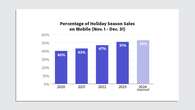With just weeks left until voters head to the polls, Democrats are increasingly prioritizing advertising on streaming services over traditional television.
Just days before the Democratic National Convention, the Harris campaign announced plans to reserve at least $370 million in advertising buys for the coming weeks; $200 million of that will be spent on digital ads, with much of it reportedly going to streaming services like Hulu and the Roku Channel. That’s markedly different from the last presidential election cycle, when both consumer eyeballs and political ad dollars were still firmly married to traditional TV.
“This is the first presidential election where connected television advertising has been available at scale,” says Mark Jablonowski, president and CTO of DSPolitical, which helps Democratic campaigns with their digital advertising efforts. “Four years ago, it just wasn’t there.”
Consumers are experiencing this shift to widely varying degrees, depending on the state they live in as well as which streaming service they subscribe to. While some services are already saturated with campaign ads, others do not allow political advertising at all—making their viewers all the more elusive to both political parties.
TV has reached a tipping point
There’s a simple explanation as to why campaigns are reallocating ad dollars to streaming: It’s where voters are spending more and more of their time. Cord-cutting has chipped away at traditional pay TV for years, but the trend accelerated during the pandemic. Comcast, the nation’s largest cable TV company, reported about 13 million pay TV subscribers in its most recent quarterly report, a huge dip from 20 million in 2019.
At the same time, streaming has exploded. Streaming device maker Roku reported in early 2020 that its customers were streaming around 12 billion hours of programming per quarter. Since then, that number has grown to 30 billion-plus hours per quarter. In July, streaming accounted for a record-breaking 41.4% of all TV usage in the U.S., according to Nielsen. Cable came in as a distant second with 26.7%, while broadcast TV accounted for 20.3%.
“We’ve seen a massive shift in the way content is consumed, the way television is accessed,” says Jaime Vasil, VP of candidates and causes at ad tech company Basis Technologies.
As streaming grew, so did the ability for advertisers to reach consumers on their smart TVs. Almost every paid streaming service now offers a cheaper tier that includes some ads, and free, ad-supported services have proven particularly popular with consumers. Fox-owned Tubi, which doesn’t charge any subscription fees, is now as widely used as Disney+, according to Nielsen, and has surpassed Max, Peacock, and Apple TV in monthly viewing time among U.S. audiences.
Faced with these rapidly shifting consumption habits, political campaigns are still playing catch-up. In fact, out of the record-breaking $12.3 billion that political advertisers are forecast to spend this year, 57% is still expected to go to traditional TV, according to eMarketer. Streaming ad spending, meanwhile, is estimated to amount to around $1.6 billion. And while that forecast was made in January, long before the recent changes atop the Democratic ticket led both campaigns to reassess their strategies and spending, it does point to the complex reality of political advertising in 2024: Digital video budgets are reaching a record high, but up and down the ballot, the lion’s share of ad dollars still goes to traditional TV.
That’s in stark contrast to consumer brands, which are increasingly abandoning traditional TV networks. The Interactive Advertising Bureau, an online advertising trade group, estimates that advertisers will spend more on digital video than traditional television for the first time ever this year. Since 2020, spending has shifted by 20% from TV to digital video, according to those estimates. “Political campaigns have been behind the times compared to corporate marketers,” Jablonowski says.
No room for politics on Netflix and Amazon
Campaigns also face a more challenging environment than consumer brands. Netflix, which introduced a budget-priced subscription plan with ads in 2023 and now shows ads to 40 million monthly users, does not allow any political ads on its service. Neither does Amazon, which began showing ads to Prime Video subscribers in January.
Such restrictions force political advertisers to double down on the streaming services that do welcome them. This can result in inventory shortages and drive up ad prices, especially in crucial swing states. Data published by Samsung shows that political advertisers paid anywhere from $50 to $70 per thousand video ad views (known among industry insiders as CPMs, or cost per mille) for their campaigns on the company’s smart TV platform this month.
That’s already on the higher end of typical connected TV ad rates, but Vasil expects rates to rise even further in the coming weeks. “Even for the Democratic National Convention, I saw CPMs come through at over $100,” she says. “Prices are going up quite a bit between now and election day in certain markets.”
To consumers who cut the cord to get away from the annoyances of traditional pay TV, the resulting ad onslaught may feel a bit like a déjà vu—especially if they live in swing states. Some of those swing state viewers have taken to online forums to complain about the ad onslaught. One Reddit user recently complained that nonstop advertising for a particularly divisive candidate “killed the vibe” of his favorite baking show. “I don’t even want to see ads for ‘my side’ of politics,” that user wrote. “I just want to relax with my family.”
To which another Reddit user responded: “Welcome to 2024!”










No comments